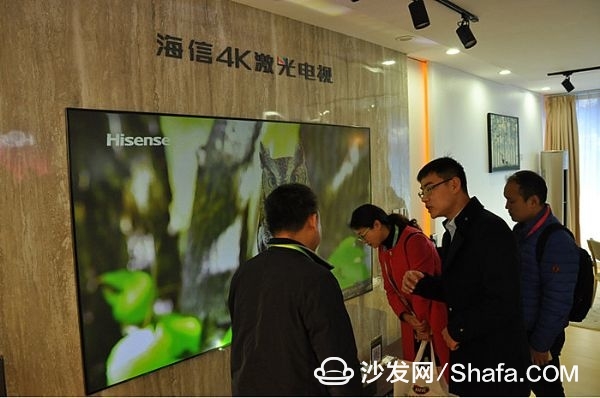A great laser TV system is impossible without a top-notch anti-light curtain—those so-called "no screen" concepts and "300-inch giant screens on the wall" are often dismissed by industry professionals as "misguided." But what exactly makes anti-light curtains so magical?
Why do we need anti-light curtains? The answer is simple: our laser TVs require proper lighting conditions to perform optimally. Lighting environments play a crucial role in determining the screen's contrast. Many consumers prioritize brightness when evaluating projector systems, which isn't inherently wrong since brightness impacts both the product's application and price. However, most home projectors and laser TVs in the 3,000 to 4,000-lumen range don’t offer much flexibility in terms of brightness.
Take a look at this image:

A quality picture depends on more than just brightness—it hinges on color and contrast. The projector’s primary function isn’t illumination but creating contrast. Brightness matters because it supports the energy needed for contrast. However, contrast doesn’t solely rely on brightness. It’s about the difference between "bright" and "not bright." In a dark setting, the "not bright" levels are controlled by the projector itself. In well-lit environments, these levels are influenced by ambient light.
Typically, indoor lighting, whether natural or artificial, rarely drops below 100 lumens. Often, it can go up to 200 lumens or more. This means the projection screen will always have at least 100 lumens of brightness, regardless of whether it’s a large or small screen. For a 3,000-lumen projector, even a 60-inch screen would result in a contrast ratio hard-pressed to reach 30:1. In such scenarios, the screen appears uniformly grey, lacking depth and vibrancy.
However, if you use a "light-resistant screen," most ambient light is absorbed instead of being reflected. Instead of 100 lumens reflecting off the screen, only 30 or even 5 lumens might be reflected. Combined with the human eye’s ability to adjust its sensitivity to light, the screen can present a "true" black.
Thus, the simplest reason to opt for an anti-light curtain is that it manages ambient light effectively, allowing for better contrast and a superior viewing experience.
High-tech anti-light curtains operate on two principles: absorption and optical reflection. Most anti-light curtains on the market are dark-colored because deeper hues absorb more light. Greater absorption means less reflection, leading to sharper contrast.
From this standpoint, any dark curtain could serve as an anti-light curtain. However, absorption technology has limitations: too much absorption results in zero screen brightness. Since projection screens rely on reflected light, achieving perfect absorption isn’t ideal—some brightness must be retained to avoid sacrificing screen clarity.
This limitation means that purely absorptive screens will struggle to provide sufficient light resistance.
Secondly, optical reflection plays a vital role. Laser TVs utilize reflective short-throw lenses. The angle between the projector’s beam and the screen is small. Ambient light, however, originates from overhead lights, window sunlight, and diffuse reflections indoors. These rays usually form large angles with the screen, and much of their energy hits the screen nearly perpendicularly.
Using the differing angles of projection and ambient light, the screen can be designed with a unique optical structure—this structure reflects most ambient light back in the opposite direction of the projection beam while diverting vertical ambient light outside the imaging field of view. This leaves high-contrast, clear images for the viewer.
Refer to this diagram:

For reflective anti-light curtains to work efficiently, certain conditions must be met: First, the projection light must have a significant angular difference from ambient light to allow for an effective mirror design. This limits the use of reflective anti-light curtains in long-throw projection setups. Second, the screen's mirror structure and the projector's angle must align correctly during installation. Third, larger screens pose challenges for short-throw lenses in maintaining small enough projection angles and screen angles.
Additionally, some anti-light curtains employ Fresnel bionic structures. Combining absorption and optical reflection yields excellent results. However, this doesn’t mean further refinement isn’t possible. High-end Fresnel curtains adopt more complex anti-light structures tailored to the specific angles between the screen and projector. While this enhances picture quality, it comes at a cost: higher production expenses and potential difficulties if the projector or screen dimensions change.
If optical reflection is used, anti-light curtains gain a clearer understanding of "resolution," especially important for 4K screens. Each reflection structure must be compact and precise to preserve pixel detail. Furthermore, these curtains are typically rigid rather than flexible, offering better flatness but making them harder to move.
In summary, the core anti-light technologies of curtains include absorptive coatings and optical reflective structures. Laser TV curtains usually combine both technologies, with the optical structure ideally featuring multiple independent designs based on incoming light angles.
Given the importance of anti-light curtains, market confusion is unsurprising. A good 100-inch curtain costs between $5,000 and $7,000, with prices rising sharply as size increases. Some unethical businesses exploit this by simply draping dark curtains over screens or applying absorbing coatings to high-quality curtains. Consumers should seek "optical anti-light curtains" and purchase from reputable brands offering complete systems. Such sellers provide better post-sale services, including careful adjustments during installation.
In conclusion, the standard of light-resistant screens distinguishes laser TV applications from traditional projections. Laser TVs require advanced screens to truly earn the title of "TV," ensuring clarity and beauty even in well-lit environments.
For more insights into smart TVs and boxes, check out China’s influential TV box and smart TV site, Sofa Butler (http://), offering news, reviews, and resources for TV boxes, smart TVs, and related software.
Comcn Electronics Limited , https://www.comencnspeaker.com